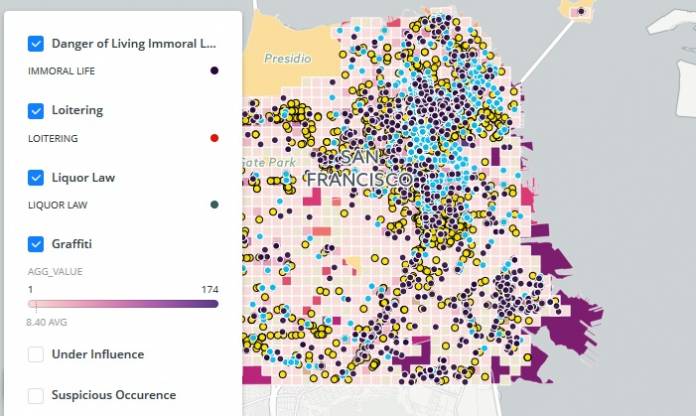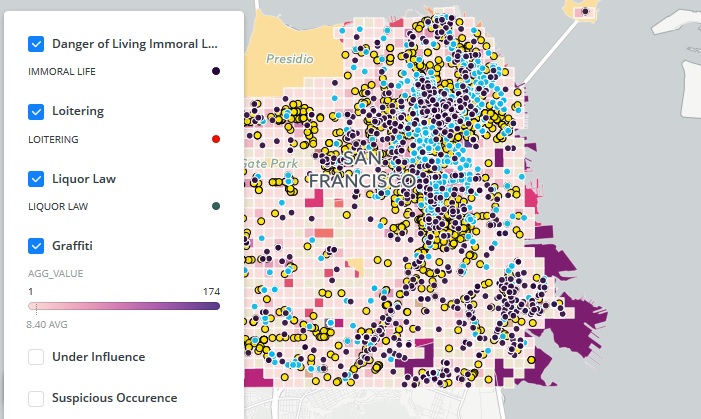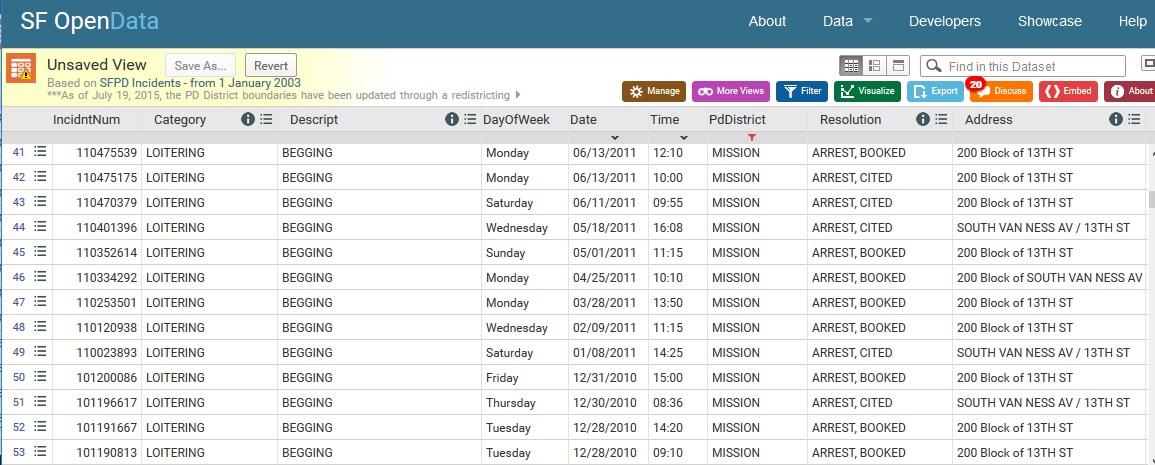
San Francisco police have issued tens of thousands of citations for minor quality-of-life crimes in recent years, and most of them are clustered in the Tenderloin, Soma, and the Mission, a new analysis of crime data shows.
The data compiled by the Anti Eviction Mapping Project shows, among other things, 2,382 citations for Loitering and 950 issued to juveniles for “Danger of Leading an Immoral Life.”

The data goes back to 2004, but the bulk of the citations were issued between 2008 and 2014, while the Mission and Soma were seeing rapid gentrification.
The interactive map, which you can check out here, also tracks citations for liquor law violations (like carrying an open container), graffiti, under the influence, and “suspicious occurrence.”
There were more than 30,000 citations in the Suspicious Occurrence category.
The Immoral Life cites are the most surprising and unusual. It’s an old and somewhat odd law that was used in the early 1970s to round up young hippies in Berkeley. It’s now used, according to police, as a way to signify that a juvenile has been entered into the law-enforcement system, often as a secondary charge to another crime.
Giselle Talkoff, a public-affairs office at SFPD, said that the law (sections 601 and 602 of the state Welfare Code) is used when “a parent contacts us, and their kid is out of control, truant, drug addicted and they need help.” She said the department works with groups like Huckleberry House to find shelter for young people who can’t stay with their families.
Denise Coleman, who works in intake at Huckleberry House, told me she’d never heard of that citation.
Jodi Schwartz, executive director of LYRIC, the center for LGBT youth, said she hasn’t heard of young people getting that citation, either.
Several youth counselors told me that Sections 601 and 602 are “status offenses,” meaning that juveniles are not supposed to be detained or booked for them.
But many of the citations listed include results like “juvenile booked” or “juvenile arrested.”
Most of them are issued late at night, and appear to be handed out on the street, not at any specific address.
When I sent the data to Talkoff, she did some further research and told me that the oddity was probably the result of a very old report-writing code. Most of those citations were added on to another crime – say, petty theft – because “that’s the way we get juveniles into the system.”
The cops choose that code from a drop-down menu on their reports. “It needs to be updated,” she said.
The loitering citations are also a bit fuzzy. Technically, loitering means standing around (“remaining in a certain place for no apparent reason,” according to Black’s Law Dictionary. That’s not really a crime these days; people have a right to stand on the sidewalk in a public place.

But loitering gets used as a sweeping citation for all kinds of things, including trespassing (standing around on private property) and other activities that the cops just want to break up.
(I was arrested once for “conspiracy to loiter.” Think about that one for a second.)
Most of the citations and arrests in the category of “loitering” involve offenses like “obstructing a public thoroughfare” or “unlawful assembly.” They also include, according to the department’s crime database, “begging” – yes, that’s a crime for which people are arrested. Some are arrested for standing too close to an ATM machine.
There were nearly 4,000 citations for liquor law violations, 2,057 them for “consuming alcohol in public view”, the data shows. That offense, of course, does not apply to the many patrons of bars and restaurants that have outdoor seating; there is conspicuous public consumption of alcohol every evening along Valencia Street, by people who have paid $10 or more for a cocktail or a glass of nice wine at upscale establishments. I have never heard of any of them facing legal consequences.
Meanwhile, 514 people who were not sitting in such comfortable surroundings got popped for drinking in public view. The map shows a lot of these quality-of-life arrests taking place along Mission Street, a block away from the Valencia food-and-drink corridor.
The vast majority of the public-consumption incidents ended with someone being arrested and booked.
You can look at the map and see where the cops are focusing on these sorts of offenses. It’s not a surprise that many are clustered in the Tenderloin and Soma, where minor-offense citations are commonly used to discourage and sometimes detain homeless and low-income people.
But the clusters also follow a pattern of places where wealthier people are moving into neighborhoods that have existing low-income and working-class populations.
I’m not sure why the citations spiked a couple of years ago and have tapered off since; possibly, the people most commonly targeted for these offenses have so effectively been driven out of town, the communities so economically cleansed, that the cops have less to do.
But it’s pretty clear that issuing tens of thousands of citations and arresting tens of thousands of people for what are really pretty chickenshit crimes takes police resources away from, say, solving homicides (which the city is pretty bad at).
Check out the maps and the data sets. It’s fascinating.



The frequented “the right spots”. You men “The Right Spot”? Lots of well-off whiteFolks there.
I lived in the Mission for a long time, too (23rd near Shotwell). Surprised we never ran into each other. Neither the homeless nor the “well off” got arrested much. And no doormen anywhere.
No, they just frequent the “right” in spots. I lived for about ten years in the Mission, and had the misfortune to be near one of those places. Trust me, homeless are not the only ones urinating on sidewalks, and such. I will grant, they did finally make the place stop blocking the sidewalk. At first, they would put up a big canopy and have a doorman with a velvet rope. A crowd would gather to attempt admission, and locals would have to walk out into the street to get by. What is obvious to you, is fueled by your bigotry.
Thanks for playing.
Shusser believes the police won’t arrest public drunks if they are “clearly well off.” What’s the sign that drunks are “clearly well off”? Do they flash their wallets? Vomit on their gucci shoes?
If the law specifies that “consuming alcohol in public view” is illegal, but people are allowed to do it if they are the “right kind” of people, then that is wrong. Let’s face it, no one gets arrested for going on a pub crawl, even if they are falling down drunk, as long as they are clearly well off.
The people gentrifying neighborhoods are using the police to drive out the current residents. That should NOT be allowed.
For over a year (I think it might be since Sept. ’15) SFPD has been telling us at the Coalition on Homelessness that their system for tracking “Quality of Life” citations has been broken. So that might be connected to the decrease in numbers.
“But the clusters also follow a pattern of places where wealthier people are moving into neighborhoods that have existing low-income and working-class populations.”
The implication here is that homeowners in gentrifying neighborhoods are making the police arrest working-class people. I believe they are arresting alleged criminals, some who working-class and most who are not. The Tenderloin, and SOMA (though not as much as before) are high-crime neighborhoods. It shouldn’t surprise anyone that many arrests are made there.
As for alcohol consumption…Yes, Virginia, you can legally drink in a restaurant or a bar with outdoor seating. (“I have never heard of any of them facing legal consequences”). That’s different than public drunkenness. Hate to have to state the obvious.